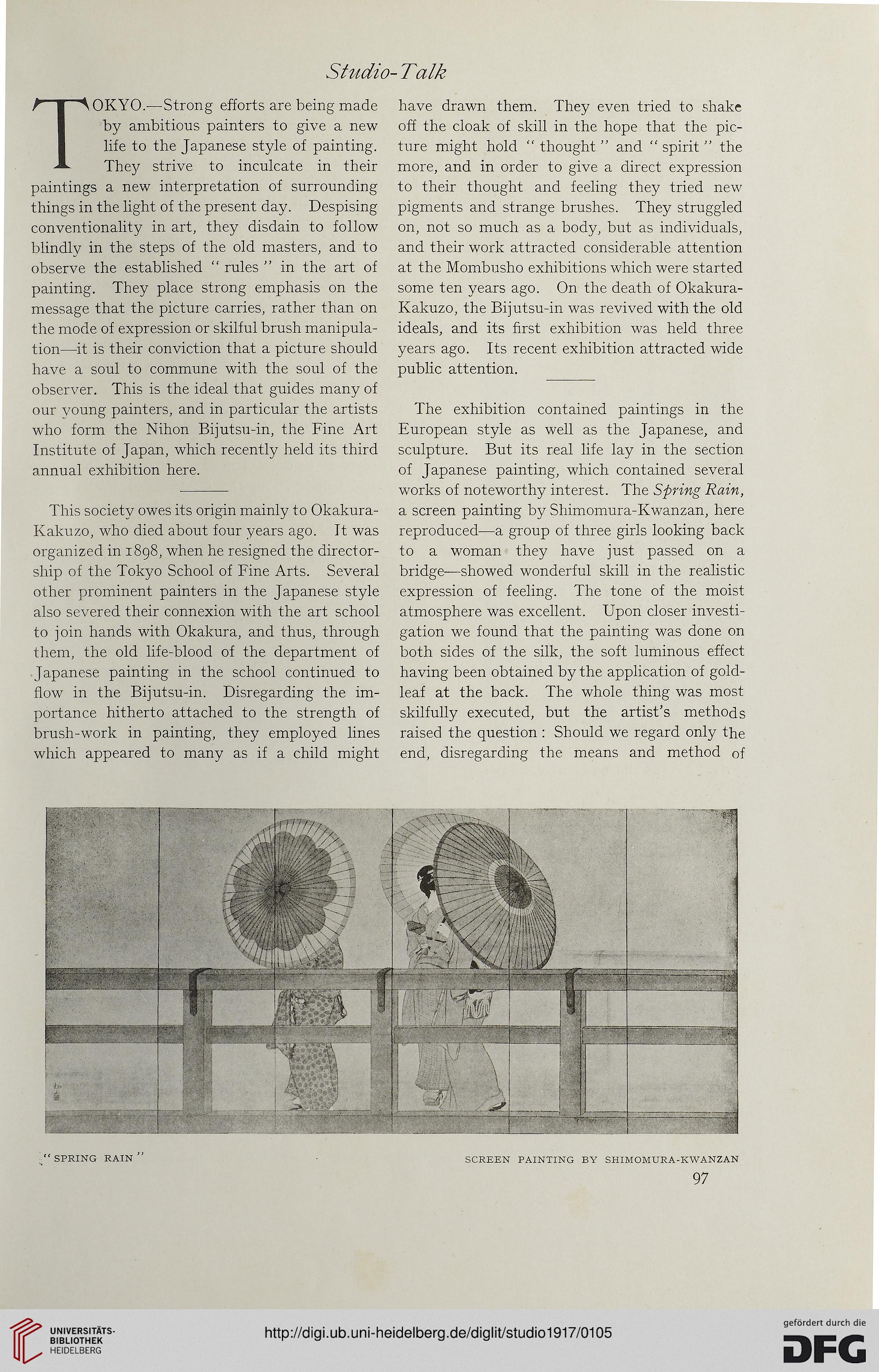Studio-Talk
TOKYO.—Strong efforts are being made
by ambitious painters to give a new
life to the Japanese style of painting.
They strive to inculcate in their
paintings a new interpretation of surrounding
things in the light of the present day. Despising
conventionality in art, they disdain to follow
blindly in the steps of the old masters, and to
observe the established “ rules ” in the art of
painting. They place strong emphasis on the
message that the picture carries, rather than on
the mode of expression or skilful brush manipula-
tion—it is their conviction that a picture should
have a soul to commune with the soul of the
observer. This is the ideal that guides many of
our young painters, and in particular the artists
who form the Nihon Bijutsu-in, the Fine Art
Institute of Japan, which recently held its third
annual exhibition here.
This society owes its origin mainly to Okakura-
Kakuzo, who died about four years ago. It was
organized in 1898, when he resigned the director-
ship of the Tokyo School of Fine Arts. Several
other prominent painters in the Japanese style
also severed their connexion with the art school
to join hands with Okakura, and thus, through
them, the old life-blood of the department of
Japanese painting in the school continued to
flow in the Bijutsu-in. Disregarding the im-
portance hitherto attached to the strength of
brush-work in painting, they employed lines
which appeared to many as if a child might
have drawn them. They even tried to shake
off the cloak of skill in the hope that the pic-
ture might hold “ thought ” and " spirit ” the
more, and in order to give a direct expression
to their thought and feeling they tried new
pigments and strange brushes. They struggled
on, not so much as a body, but as individuals,
and their work attracted considerable attention
at the Mombusho exhibitions which were started
some ten years ago. On the death of Okakura-
Kakuzo, the Bijutsu-in was revived with the old
ideals, and its first exhibition was held three
years ago. Its recent exhibition attracted wide
public attention.
The exhibition contained paintings in the
European style as well as the Japanese, and
sculpture. But its real life lay in the section
of Japanese painting, which contained several
works of noteworthy interest. The Spring Rain,
a screen painting by Shimomura-Kwanzan, here
reproduced—a group of three girls looking back
to a woman they have just passed on a
bridge—showed wonderful skill in the realistic
expression of feeling. The tone of the moist
atmosphere was excellent. Upon closer investi-
gation we found that the painting was done on
both sides of the silk, the soft luminous effect
having been obtained by the application of gold-
leaf at the back. The whole thing was most
skilfully executed, but the artist’s methods
raised the question : Should we regard only the
end, disregarding the means and method of
“ SPRING RAIN”
SCREEN PAINTING BY SHIMOMURA-KWANZAN
97
TOKYO.—Strong efforts are being made
by ambitious painters to give a new
life to the Japanese style of painting.
They strive to inculcate in their
paintings a new interpretation of surrounding
things in the light of the present day. Despising
conventionality in art, they disdain to follow
blindly in the steps of the old masters, and to
observe the established “ rules ” in the art of
painting. They place strong emphasis on the
message that the picture carries, rather than on
the mode of expression or skilful brush manipula-
tion—it is their conviction that a picture should
have a soul to commune with the soul of the
observer. This is the ideal that guides many of
our young painters, and in particular the artists
who form the Nihon Bijutsu-in, the Fine Art
Institute of Japan, which recently held its third
annual exhibition here.
This society owes its origin mainly to Okakura-
Kakuzo, who died about four years ago. It was
organized in 1898, when he resigned the director-
ship of the Tokyo School of Fine Arts. Several
other prominent painters in the Japanese style
also severed their connexion with the art school
to join hands with Okakura, and thus, through
them, the old life-blood of the department of
Japanese painting in the school continued to
flow in the Bijutsu-in. Disregarding the im-
portance hitherto attached to the strength of
brush-work in painting, they employed lines
which appeared to many as if a child might
have drawn them. They even tried to shake
off the cloak of skill in the hope that the pic-
ture might hold “ thought ” and " spirit ” the
more, and in order to give a direct expression
to their thought and feeling they tried new
pigments and strange brushes. They struggled
on, not so much as a body, but as individuals,
and their work attracted considerable attention
at the Mombusho exhibitions which were started
some ten years ago. On the death of Okakura-
Kakuzo, the Bijutsu-in was revived with the old
ideals, and its first exhibition was held three
years ago. Its recent exhibition attracted wide
public attention.
The exhibition contained paintings in the
European style as well as the Japanese, and
sculpture. But its real life lay in the section
of Japanese painting, which contained several
works of noteworthy interest. The Spring Rain,
a screen painting by Shimomura-Kwanzan, here
reproduced—a group of three girls looking back
to a woman they have just passed on a
bridge—showed wonderful skill in the realistic
expression of feeling. The tone of the moist
atmosphere was excellent. Upon closer investi-
gation we found that the painting was done on
both sides of the silk, the soft luminous effect
having been obtained by the application of gold-
leaf at the back. The whole thing was most
skilfully executed, but the artist’s methods
raised the question : Should we regard only the
end, disregarding the means and method of
“ SPRING RAIN”
SCREEN PAINTING BY SHIMOMURA-KWANZAN
97




